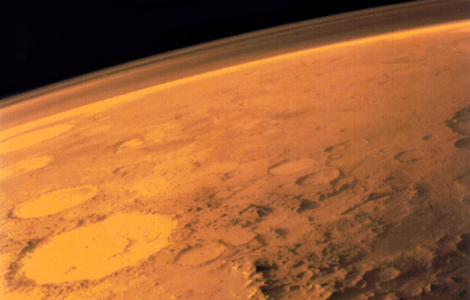MAVEN Heads for Mars
Its goal: to help scientists understand why the Martian atmosphere all but disappeared.
NASA’s Mars Atmosphere and Volatile EvolutioN (MAVEN) spacecraft, now on its way to the Red Planet following a textbook Atlas V launch today, is the first devoted exclusively to studying the Martian upper atmosphere. Assuming the rest of its journey goes as smoothly, the spacecraft is slated to arrive in orbit around the Red Planet on September 22.
MAVEN is the second and last of NASA’s (relatively) low-cost Mars Scout missions (the program has since been discontinued). It’s designed to take measurements from a highly elliptical Mars orbit over a period of one Earth year, with five “deep dips” down to about 125 kilometers altitude to sample the upper atmosphere.
The goal is to better understand how the Martian atmosphere and climate have changed over time. River valleys, shorelines, and evidence of rain on early Mars suggest that the planet was once very different than it is today. Many scientists now believe that Mars had a large northern ocean early in its history, and that even the HellasBasin, which originated from a major asteroid impact, was flooded by a huge sea. How could such a cold planet have bodies of liquid water on its surface? The prevailing theory is that the atmosphere must have been much thicker then—at least as dense as Earth’s atmosphere, with greenhouse gases such as carbon dioxide and perhaps even methane that trap heat. Today as little as one percent of the early Martian atmosphere remains. What happened?
Most scientists think the solar wind—the stream of charged particles coming from the upper atmosphere of the Sun—eroded away most of the Martian atmosphere, especially after the planet’s magnetic field, which offers protection from the solar wind, collapsed. (Because it’s so much smaller than Earth, Mars ran out of internal heat to keep the internal dynamo that generates magnetism going). That all seems to have happened about four billion years ago, after which Mars became a cold and dry planet, with occasional brief periods that were warmer and wetter.
MAVEN will measure how solar activity contributes to atmospheric loss, determine today’s escape rates, and explore the relative importance of various atmospheric loss processes. Knowing today’s escape rates won’t entirely solve the puzzle of why Mars underwent such a profound climatic change billions of years ago, but the measurements should help scientists understand the impact of solar wind on planetary atmospheres.
There are other benefits to this mission as well. MAVEN will determine ratios of stable isotopes in the atmosphere, which will help us trace the history of water on Mars. And the spacecraft will add another radio relay in Mars orbit, which will be useful for current and future landers, including InSight (due to launch in 2016) and Mars 2020.
/https://tf-cmsv2-smithsonianmag-media.s3.amazonaws.com/accounts/headshot/Dirk-Schulze-Makuch-headshot.jpg)

/https://tf-cmsv2-smithsonianmag-media.s3.amazonaws.com/accounts/headshot/Dirk-Schulze-Makuch-headshot.jpg)